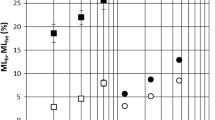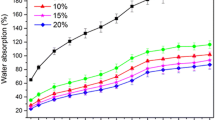Abstract
The temperature of pine rosin softening point was studied to better understand the phenomenon of resin exudation on the surface of pine boards. This problem may decrease strongly the aesthetical performance of wood used outside and is an important concern for the industry. To perform a reliable measurement of rosin properties with a small amount of sample, differential scanning calorimetry (DSC) and thermo mechanical analysis (TMA) techniques were investigated and the results compared. DSC curves on industrial rosin and acetone rosin extractives from maritime pine show a behavior similar to a glass transition in polymers. TMA measurements carried out on the same industrial rosin showed that the softening point is in the midpoint of the transition phase observed by DSC. The softening point temperature is about 45 °C for industrial rosin and about 50 °C for rosin extractives from maritime pine boards. These values are significantly lower than those usually found on other rosins measured by the ASTM E28-14 standard using the ring-and-ball method. When using heat treatment, it was observed for the first time that the thermal history of the sample can change its softening point temperature. With these results, it could be possible to develop a new strategy to reduce rosin exudation for exterior wood siding.







Similar content being viewed by others

References
Amiralian N, Annamalai PK, Fitzgerald C, Memmott P, Martin DJ (2014) Optimisation of resin extraction from an Australian arid grass ‘Triodia pungens’ and its preliminary evaluation as an anti-termite timber coating. Ind Crops Prod 59:241–247
Arrieta MP, Samper MD, Jiménez-López M, Aldas M, Lopez J (2017) Combined effect of linseed oil and gum rosin as natural additives for PVC. Ind Crops Prod 99:196–204
Artaki I, Ray U, Gordon HM, Gervasio MS (1992) Thermal degradation of rosin during high temperature solder reflow. Thermochim Acta 198:7–20
Azémard C, Vieillescazes C, Ménager M (2014) Effect of photodegradation on the identification of natural varnishes by FT-IR spectroscopy. Microchem J 112:137–149
Baldwin DE, Loeblich VM, Lawrence RV (1958) Acidic composition of oleoresins and rosins. Ind Eng Chem 3:342–346
Barabde UV, Fulzele SV, Satturwar PM, Dorle AK, Joshi SB (2005) Film coating and biodegradation studies of new rosin derivative. React Funct Polym 62:241–248
Cannac M, Barboni T, Ferrat L et al (2009) Oleoresin flow and chemical composition of Corsican pine (Pinus nigra subsp. laricio) in response to prescribed burnings. For Ecol Manag 257:1247–1254
Chen G-F (1992) Developments in the field of rosin chemistry and its implications in coatings. Prog Org Coat 20:139–167
Coppen JJW, Hone GA (1995) Gum naval stores: turpentine and rosin from pine resin, 1st edn. Food and Agriculture Organization of the United Nations, Rome
Echard J-P, Bertrand L, von Bohlen A et al (2010) The nature of the extraordinary finish of Stradivari’s instruments. Angew Chem Int Ed 49:197–201
Franceschi VR, Krokene P, Christiansen E, Krekling T (2005) Anatomical and chemical defenses of conifer bark against bark beetles and other pests. New Phytol 167:353–376
Fulzele SV, Satturwar PM, Dorle AK (2002) Polymerized rosin: novel film forming polymer for drug delivery. Int J Pharm 249:175–184
Gaillard Y, Mija A, Burr A, Darque-Ceretti E, Felder E, Sbirrazzuoli N (2011) Green material composites from renewable resources: Polymorphic transitions and phase diagram of beeswax/rosin resin. Thermochim Acta 521:90–97
Ghanmi M, Satrani B, Aafi A, ismail MR, Farah A, Chaouch A (2009) Évaluation de la qualité de la colophane du pin maritime (Pinus pinaster) et du pin d’Alep (Pinus halepensis) du Maroc (evaluation of the quality of rosin from maritime pine (Pinus pinaster) and Aleppo pine (Pinus halepensis) from Morocco). Acta Bot Gallica 156:427–435
Hawley LF, Palmer RC (1912) Distillation of resinous wood by saturated steam. J Ind Eng Chem 4:789–798
Hillis WE (1998) Deposits in heartshakes in wood. Wood Sci Technol 32:129–137
Hon DN-S, Shiraishi N (1990) Wood and cellulosic chemistry, 1st edn. Marcel Dekker Inc., New York
Joye NM, Lawrence RV (1967) Resin acid composition of pine oleoresins. J Chem Eng Data 12:279–281
Lloyd JA (1972) Distributoin of extractives in Pinus radiata. N Z For Serv 8:288–294
Maiti S, Ray SS, Kundu AK (1989) Rosin: a renewable resource for polymers and polymer chemicals. Prog Polym Sci 14:297–338
Muñoz GR, Estévez ÓS, González JGÁ, Sánchez EM (2014) Influence of provenance, silvicultural regime and tree shape on the quality of maritime pine (Pinus pinaster) timber. Eur J For Res 133:623–630
Narayanan M, Loganathan S, Valapa RB, Thomas S, Varghese TO (2017) UV protective poly(lactic acid)/rosin films for sustainable packaging. Int J Biol Macromol 99:37–45
Penaranda Moren MS, Korjenic A (2017) Hotter and colder—how do photovoltaics and greening impact exterior facade temperatures: the synergies of a multifunctional system. Energy Build 147:123–141
Pinto I, Knapic S, Pereira H, Usenius A (2006) Simulated and realised industrial yields in sawing of maritime pine (Pinus pinaster Ait.). Holz Roh- Werkst 64:30–36
Pio CA, Valente AA (1998) Atmospheric fluxes and concentrations of monoterpenes in resin-tapped pine forests. Atmos Environ 32:683–691
Ren F, Zheng Y-F, Liu X-M et al (2015) An investigation of the oxidation mechanism of abietic acid using two-dimensional infrared correlation spectroscopy. J Mol Struct 1084:236–243
Rissanen K, Hölttä T, Vanhatalo A, Aalto J, Nikinmaa E, Rita H, Bäck J (2016) Diurnal patterns in Scots pine stem oleoresin pressure in a boreal forest. Plant Cell Environ 39:527–538
Sahu NH, Mandaogade PM, Deshmukh AM et al (1999) Biodegradation studies of rosin-glycerol ester derivative. J Bioact Compat Polym 14:344–359
Satturwar PM, Mandaogade PM, Darwhekar GN et al (2003) Biodegradation studies of rosin-based polymers. Drug Dev Ind Pharm 29:669–677
Scalarone D, Lazzari M, Chiantore O (2002) Ageing behaviour and pyrolytic characterisation of diterpenic resins used as art materials: colophony and Venice turpentine. J Anal Appl Pyrolysis 64:345–361
Silvestre AJD, Gandini A (2008) Chap. 4—rosin: major sources, properties and applications. In: Monomers, polymers and composites from renewable resources. Elsevier, Amsterdam, pp 67–88
Tirat S, Degano I, Echard J-P et al (2016) Historical linseed oil/colophony varnishes formulations: study of their molecular composition with micro-chemical chromatographic techniques. Microchem J 126:200–213
Wiyono B, Tachibana S, Tinambunal D (2006) Chemical compositions of pine resin, rosin and turpentine oil from west JAVA. J For Res 3:7–17
Wu H, Hu Z (1997) Comparative anatomy of resin ducts of the Pinaceae. Trees 11:135–143
Acknowledgements
We gratefully acknowledge the financial support from the Nouvelle Aquitaine (France) and Landes (40, France) general councils. This work was also funded by ANR-10-EQPX-16 XYLOFOREST (Mont de Marsan, France).We also gratefully acknowledge our partners: Bardage Bois Neoclin, FCBA, FPbois, Gascogne Bois, Lesbats Scieries d’Aquitaine, Scierie Labadie, Anne-Marie Pollaud-Duliand, Jamal El Hachem, Manon Frances, Claude Cabaret and Léo Leroyer.
Author information
Authors and Affiliations
Corresponding author
Additional information
Publisher’s Note
Springer Nature remains neutral with regard to jurisdictional claims in published maps and institutional affiliations.
Rights and permissions
About this article
Cite this article
Cabaret, T., Boulicaud, B., Chatet, E. et al. Study of rosin softening point through thermal treatment for a better understanding of maritime pine exudation. Eur. J. Wood Prod. 76, 1453–1459 (2018). https://doi.org/10.1007/s00107-018-1339-3
Received:
Published:
Issue Date:
DOI: https://doi.org/10.1007/s00107-018-1339-3



